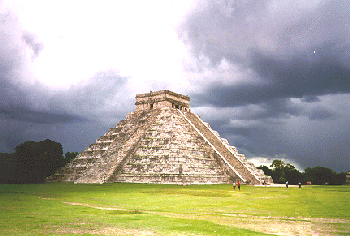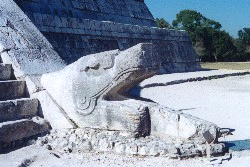
The Maya-Toltec site on Mexico's Yucatan Peninsular is one of the most extensively excavated and restored Mayan sites. Archaeologists believe the site reached it's pinnacle of occupation between 800 AD and 1000 AD, but was probably established some five hundred years previously, with the earliest settlements starting as far back as 800 BC.
The main pyramid at the complex, named after the God Kukulkan, rises some seventy eight feet above the ground and each base measures 180 feet across. The pyramid is off-set from the four cardinal points by a margin of 21 degrees. The design is simple, with a minimum of decoration. Each side of the pyramid has a huge staircase, rising up over 9 receding terraces to a small temple at the top. Of these staircases, only one has any decoration, the north facing. At the bottom of the stairwell on either side of the steps, are two large serpent heads. The serpent being the assosciated form of the God Kukulkan.
This structure has been built over an existing one. The remains of which are remarkably well preserved. Within this interior structure is an inner sanctuary, guarded at the entrance by a chak-mool. It is inside this room that the most remarkable discovery at Chichen Itza was made. This is where archaeologists found the "Red Jaguar Throne". This ia a piece of stone which has been carved into the shape of a jaguar, painted red and has jade pieces inlaid to represent the jaguar's spots and eyes, and the teeth are real jaguar teeth. Although Toltec in style the sculpture pre-dates their arrival by centuries.

This simplicity, is, however somewhat misleading. The building seems to have been built as an architectural representation of their calendar and beliefs. The builders encoded these "sacred numbers" within the design of the pyramid. The temple at the top rests on a series of 9 platforms, each representing one of the levels of the Mayan underworld, with the ninth being the lowest. Each of the staircases, faces towards a cardinal point, and represents the four quarters of the universe, each denoted by a colour. Red for the east, black with the west, white with the north and yellow with the south. The four staircases each contain 91 steps, making a total of 364, and if the step at the top is added, the total becomes 365, the number of days in a calendar year. Each staircase divides the 9 terraces into two, giving us the number eighteen, the number of months in a year. There are 52 recessed square panels on each face of the pyramid, representing one "calendar round" of 52 years. The pyramid is aligned in such a way that, twice a year, at the two vernal equinoxes in spring and autumn, the "Serpent God Kukulkan" can be seen descending the staircase to the two snake heads at the base as a shadow. This bi-annual phenomenon attracts huge crowds every year to witness the spectacle.